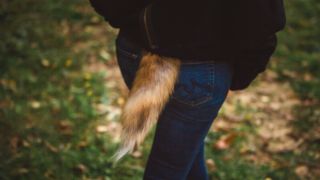From mermaids to the ancient Babylonian scorpion people, stories of humans with tails abound in mythologies from around the world. Often, these figures possess some sort of magic power or wisdom beyond mortal understanding.
But what would it be like if humans actually had tails? How would the extra appendage change our daily lives? And what would they look like?
For some people, this is more than a thought experiment; in rare instances, babies with spina bifida — a condition in which a baby is born with a gap in the spine — or an irregular coccyx might be born with a vestigial “pseudotail.” These fleshy outgrowths often contain muscle, connective tissue and blood vessels, but not bone or cartilage, according to research published in the journal Human Pathology (opens in new tab). They are not functional and are usually removed shortly after birth.
Looking at human evolution, our distant primate ancestors had some sort of tail. Tails disappeared in our direct lineage around 25 million years ago, when great apes diverged from monkeys. Our ancestors may have ditched the extra appendage to save energy and calories as they evolved better bipedal balance. But of course, tailed primates are still hanging around today.
Related: Why haven’t all primates evolved into humans?

Certain species of monkeys native to South and Central America (dubbed “New World” monkeys, a phrase coined by European colonizers and later picked up by scientists) have prehensile tails — tails that can grasp objects — that can curl around tree limbs and even support their body weight, according to Field Projects International (opens in new tab), a nonprofit research and educational group. But our closest living tailed relatives are the so-called “Old World” monkeys that live in Africa, Asia and southern Europe, such as baboons and macaques, which use their tails mostly for balance. “None of them has a prehensile tail, because that’s a step back down in the family tree,” Peter Kappeler (opens in new tab), an evolutionary anthropologist at Göttingen University in Germany, told Live Science.
So our tails probably wouldn’t be prehensile. However, Kappeler said, that doesn’t necessarily mean they would be useless. A long, furry tail like a macaque’s could be useful to wrap around ourselves for warmth, like a built-in scarf. And if we had evolved to hibernate during the winter, our tails could come in handy as a fat-storage system (opens in new tab) (a strategy employed by some non-primate mammals, such as beavers).
Looking beyond our primate relatives, “there are other tailed bipeds that we model ourselves after,” Jonathan Marks (opens in new tab), an anthropologist at the University of North Carolina at Charlotte, told Live Science. For example, kangaroos sport a robust tail that they use like a tripod, which helps to support their weight and adds power to their bounding stride. Extinct theropod dinosaurs, such as Tyrannosaurus rex, had stiff, muscular tails that may have acted like a rudder when they ran.
However, having a tail like one of these creatures would alter our stride. For example, a T. rex-style tail would force us to lean forward at the hips, holding our chests parallel to the ground rather than upright. A kangaroo tail would be hard to maneuver without hopping — otherwise it would drag annoyingly on the ground. “It’s a very different mode of locomotion,” Marks said.
And, Marks noted, it could be difficult to avoid inadvertently hurting our tails while going about our daily lives. As any cat owner knows, long tails are prone to being stepped on or accidentally shut in doors. Meanwhile, short tails could make it hard to sit in a chair without some modifications. “Clearly, if we had tails, we would need to redesign carseats and bathing suits,” Marks said.
Given the human impulse to adorn ourselves, tails could (and likely would) open up a host of new fashion possibilities. The oldest pieces of jewelry date back 100,000 years, Michelle Langley, an archaeologist at Griffith University in Australia, wrote in The Conversation (opens in new tab). It’s easy to imagine our ancestors developing accessories like tail rings, tail warmers, or even tail hairnets alongside baubles like necklaces and earrings.
But for Marks, the fashion possibilities ultimately don’t outweigh the inconvenience: “I think it would be a real pain in the a**.”
Hits: 0











